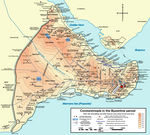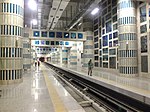Yenikapı railway station

Yenikapı is an indefinitely closed railway station on the İstanbul-Halkalı Line in the Yenikapı neighborhood of Istanbul, Turkey. The station was built in 1872 by the Oriental Railway which was then taken over by the Turkish State Railways in 1937 and electrified in 1955. The station is situated near the south end of the busy Gazi Mustafa Kemal Paşa Boulevard and one block north of Kennedy St, two major inner-city roadways and is 4.8 km (3.0 mi) west of Sirkeci Terminal. Due to the rehabilitation of the line between Halkalı and Kazlıçeşme for future Marmaray commuter service, Yenikapı was indefinitely closed on 19 March 2013. On 29 October 2013, the new underground Yenikapı railway station, which makes up a part of the new Yenikapı Transfer Center, was opened along with the trans-Bosphorus Marmaray tunnel. The new Yenikapı complex is located right next to the existing railway station and is serviced by 3 lines of the Istanbul Metro.
Excerpt from the Wikipedia article Yenikapı railway station (License: CC BY-SA 3.0, Authors, Images).Yenikapı railway station
Alboyacılar Sokağı, Istanbul
Geographical coordinates (GPS) Address Nearby Places Show on map
Geographical coordinates (GPS)
| Latitude | Longitude |
|---|---|
| N 41.004722222222 ° | E 28.9525 ° |
Address
Yenikapı
Alboyacılar Sokağı
34096 Istanbul
Türkiye
Open on Google Maps









